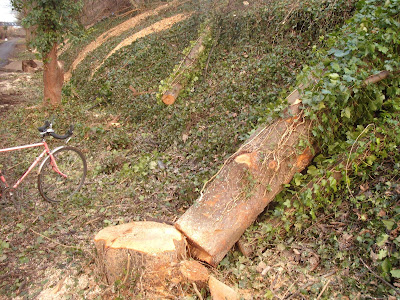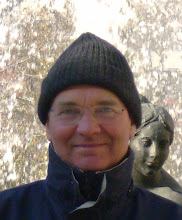As we wake up today to find that all the slush and water from yesterday's slight thaw has frozen solid to ice, thanks to overnight temperatures that reached -7° C, many of us might have cause to wonder why nothing seems to be done about making at least some of our pavements safe to walk on. Even yesterday late afternoon some predictably lethal patches were claiming victims, like the Richmond Hill/Queen's Road junction highlighted
here on Monday.
As also discussed here on Monday, Bristol City Council's
policy is to grit the main roads but not the footways (pavements), leaving pedestrians to fend for themselves. The Council's justification for this seems to be that if they did anything for pedestrians at all they would then be held responsible for all pavements, although the same logic does not seem to apply to motorists. There are of course one or two exceptions, like the carefully cleared ramps up to the entrance to the Council House (below). At least they are keeping their own house in order.
All the Council appear to do as far as us lowly pedestrians are concerned is to refer us to their extensive collection of
grit bins, although Cotham Councillor Neil Harrison does say on his
blog that "Pavements on the main roads get gritted by the manual road cleaners on their normal rota". Well there was precious little evidence of that yesterday. The only pavements that had been cleared appeared to have been done on a piecemeal basis by adjacent shop keepers, as we see below in Park Street, which apart from being a major pedestrian thoroughfare is also rather steep and you might think something of a priority for gritting.
So what about these grit bins. I can confirm that all the ones I inspected (yes, I am that sad) are full of grit, but the grit isn't getting where it's needed because the Council seem to have overlooked a rather vital link in the chain. Just how do they suppose the grit is going to get spread on our pavements? Cheery teams of volunteers working selflessly to improve their communities? A nice idea but unfortunately that's not the nature of our society. So the grit remains untouched in hundreds of grit bins spread around the city.
But what about Cllr Harrison's claim that "Pavements on the main roads get gritted by the manual road cleaners on their normal rota"? It seems we spend
£5.5 million of street cleansing, which averages out at about £10,000 a day, enough to employ a hundred or so Street Cleaning Operatives you might think. So what were our small army of Street Cleansing Operatives up to yesterday? I happened across one and followed discreetly for a while (that's about as good as it gets for me these days). Totally ignoring the snow and slush, he busied himself trudging around in a forlorn attempt to find items of litter to pick up. When our streets are crying out for gritting this is just totally stupid (not that I blame the Operative
per se - I presume he was just doing as instructed).
By chance I came across some info about York's response to snow and ice.
We see that despite being a relatively flat city they appear to have a comprehensive plan which includes treating the pavements on many strategic pedestrian routes with no less than eight downloadable maps showing exactly which pavements will be kept clear. So York's a bit further north and gets more snow, but is that really any excuse for Bristol City Council's comparatively pisspoor response?
Later edit: this post got 'retweeted' on Twitter a fair bit and there is now a
#GritforBristol topic.


































